Knowledge and collaboration are essential for any organization. When your teammates and clients have more information at hand, they’re able to work smarter and more efficiently.
Knowledge management systems come with powerful features to enable internal and external knowledge transition and collaboration.
In today’s guide, we’ll show you everything you need to know about knowledge management systems, as well as the criteria you need to select one for your business. Let’s begin with a definition.
Don’t miss more quality content!
What is a knowledge management system?
A knowledge management system (KMS) is a platform that helps you get the right knowledge to the right people, at the right time. Knowledge management is a complete practice that involves categorizing information to achieve specific goals — and knowledge management systems help you do it more efficiently.
A KMS benefits multiple parties in an organization, including:
- External: prospects, users, board members, and other stakeholders
- Internal: knowledge managers, content creators, customer support team, and any other team in your organization
But maybe a basic computer folder would do the job. The truth is, A KMS does a lot more than store knowledge and get it to the right people.
Why does your organization need a KMS?
When you adopt a KMS, all of your information is in one place and it all serves a specific purpose.
The stages of the knowledge management cycle—as shown below—work together, help you turn disparate knowledge and information into a structured system to train, inform, and help employees and customers.
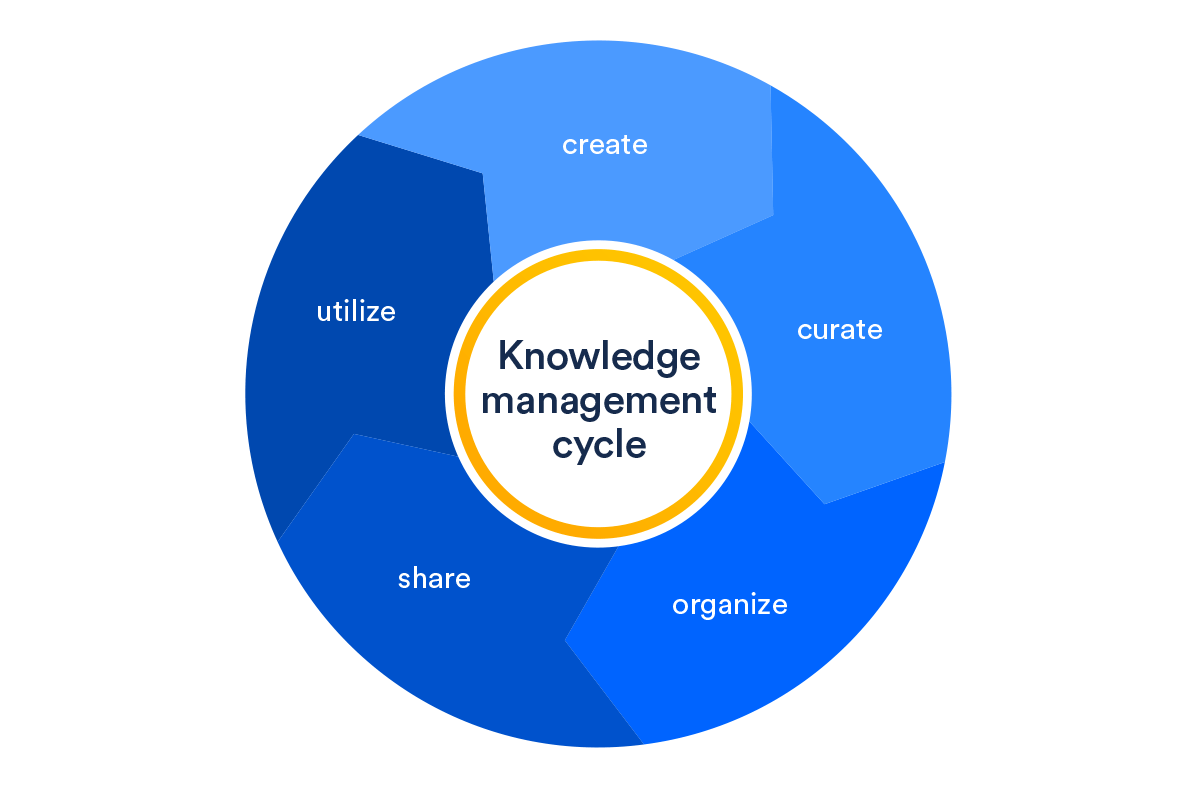
By categorizing knowledge, your customers and employees can more fully understand your processes, products, services, and culture.
For example, let’s say that you’re a support agent and a customer is struggling with a certain feature.
In this case, a knowledge management system not only helps you find a solution faster, but it’ll also document how you solved the issue. This way, future agents would be able to solve similar problems more efficiently.
Your system could even inform future product development, so new iterations won’t have the same issue. In short, a KMS is the strategic capturing, categorization, and sharing of organizational knowledge.
We’ll cover these elements in more detail a bit later, but first, let’s answer a major question.
Don’t miss more quality content!
What is the difference between a knowledge base and a knowledge management system?
People often use both terms interchangeably. Even though they’re related, the terms have different meanings.
Knowledge management systems serve as a single source of truth for both external and internal parties and enable organizations to segment information based on different user groups.
Knowledge bases are self-serve platforms where customers can find information.
A KMS helps you store and deliver information, streamline the capture, categorization, and consumption of knowledge, and improve the overall efficiency of the organization.
Following the support agent example from earlier:
A knowledge base allows the agent to browse through existing documentation for a solution or direct the customer to the right document so she can solve the problem herself.
A knowledge management system, on the other hand, requires a more strategic approach to managing institutional knowledge.
When you’re dealing with large databases, storing and organizing information isn’t enough. You need specialized procedures that make your team more efficient when looking for specific information.
To do it, knowledge management systems rely on a variety of activities and elements, including:
- A knowledge repository: a single source of truth where people can find all the company knowledge
- Collaboration platform: a platform that’s suitable for collaboration between members
- Communication and discussion: features that help your team communicate in context
- Alignment with culture: an organizational culture that encourages members to learn and grow
In this scenario, the support agent would be able to solve more complex problems without needing to send the case to an IT department or more specialized teams.
Knowledge bases are often static. Of course, you update them with new content and information, but they don’t have the specific procedures to measure the effectiveness of the knowledge you’re transmitting nor help you monitor the ROI of such information.
KMS is a system that turns sharing knowledge into a true discipline. In other words, knowledge bases depend on a KMS to become fully efficient.
What’s the main objective of a knowledge management system?
Whether it’s from teammates, leadership, consultants, or customers, your organization is always producing knowledge.
When sales representatives close a deal, they’re producing information that can be helpful to close more deals in the future. When the HR department hires talent, they’re producing knowledge to hire better talent later on.
And when customers use your products or services, they’re also producing information that can help you improve your business.
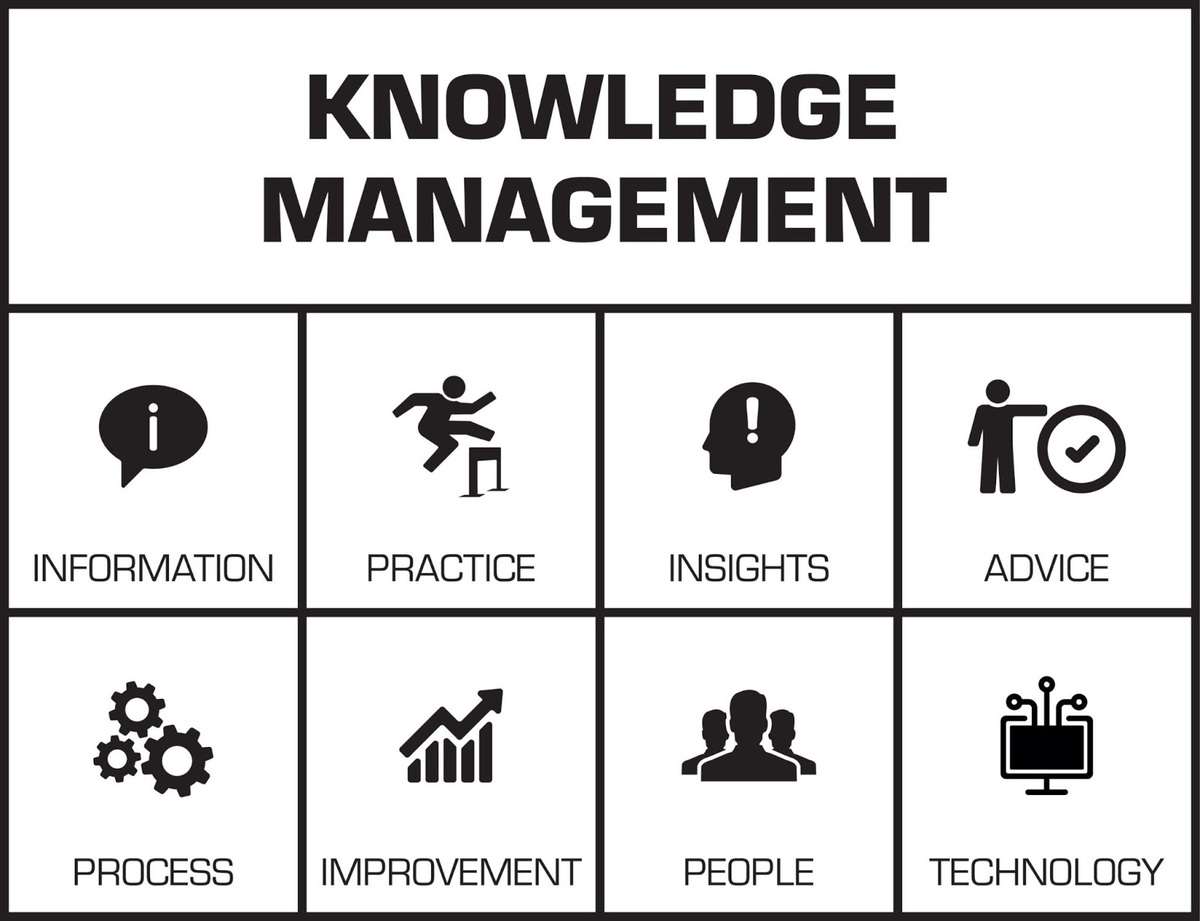
This knowledge is often stored in documents, processes, emails, blog posts, and many other formats. Creating a blog post or guide is an easy way to make information more accessible.
If you don’t have a system to record, document, and share successful sales conversations with your sales team, improving your sales scripts and sales procedures is much harder.
If you aren’t documenting customer feedback, you won’t be able to pinpoint where your products and services are least efficient.
If your knowledge isn’t easily accessible for everyone when they need it, you’ll deal with tons of issues in the long run.
Imagine that all of a sudden, one of your key employees decides to leave the company. Without a knowledge management system, that person will leave with all that valuable experience and knowledge. You’d have to start from scratch again.
A knowledge management system not only makes you more efficient but also protects you when individuals who hold a lot of corporate knowledge leave the firm.Other important benefits of adopting a KMS may include:
- Improve your organization’s efficiency: save time and money by helping your team find solutions by themselves
- Make smarter decisions: with knowledge at your disposal, you’re able to make decisions faster and better
- Foster innovation: invite your team members and stakeholders to contribute and build a culture of innovation
- Help your employees grow: train your employees and help them develop their skills in a standardized way
- Improve customer satisfaction: build a better product or service with a more trained team
- Communicate better: keep everyone informed and on the same page
- Improve your workflows and processes: streamline your workflows and improve operational efficiency
With all its benefits, you’ll want to make sure your KMS is doing its job.
How can you measure the effectiveness of your knowledge management system?
Adopting a knowledge management system is an important step for any organization, but how can you tell whether it’s working?
Let’s cover some metrics you can track to measure the performance of your KMS.
Interactions
The simplest way to measure the performance of your KMS is to track how many times your clients and employees use the system.
If the number of interactions is low, you probably need some adjustments.
Consider asking:
- Is the system easily accessible?
- Does your team need special permissions or training to access the system?
- Do they even know the system exists?
- What initiatives can you implement to increase the number of interactions?
The answers to these questions may lead to potential solutions to improve your current performance.
Number of knowledge management documents used to solve organizational problems
Ensuring your team is using the system is a crucial step. But once people adopt it, you need to make sure they’re using it for the right purpose.
For instance:
- Is your team using the KMS to solve organizational problems?
- How many documents have actually been helpful?
- How many documents aren’t providing enough information to solve important issues within the organization?
By adopting a continuous improvement philosophy in your knowledge management process, you’ll eventually get rid of useless information and build a more functional system.
Contributions
Remember that knowledge management is a collaborative process that aims to capture your organization’s knowledge with the help of everyone involved.
If your team and clients aren’t contributing, you’ll never get the most out of your KMS. That’s why you should always track the number of contributions from your team members and feedback from clients.
Some softwares have reporting dashboards, that track the number of contributions :

These dashboards are fully customizable, and you can build them to track any type of data, including content status, team progress, contributions, and more. This way, you can easily track which departments are performing and underperforming and optimize your practices accordingly.
Some of these robust softwares also manage internal and external contributions in the same place. For instance, you can create two boards: one for internal contributions and one for external.
You can then invite specific teammates to each board, assign specific items — which might represent documents in progress — and add a status column to track the progress of each item.
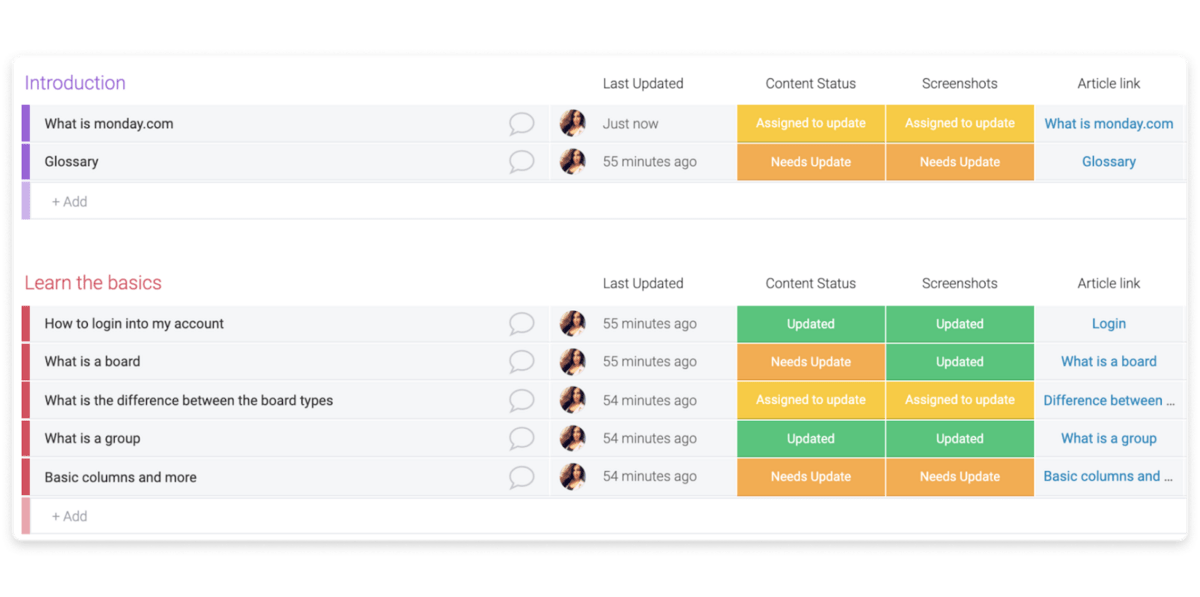
The most comprehensive platforms are also completely customizable so you can work without limits.
Search activity
Finally, you can track the progress of knowledge management systems by analyzing the search activity performed by internal and external parties.
You may want to ask:
- How many people are searching for documentation?
- What are they looking for?
- What are the top 10 search queries?
- Are they finding proper solutions and relevant information?
By understanding search behavior, you can implement initiatives to optimize your KMS based on actual intent.
Don’t miss more quality content!
Now that you understand what knowledge management systems are and why they matter, the question becomes: how can you pick the right one for your organization?
6 essential features to look for when choosing a KMS
With so many options available, choosing a KMS can be challenging. Fortunately, with the right criteria in mind, the selection process becomes way simpler.
To help you out, here are 6 features you should look for when choosing a KMS for your organization:
1. Cloud storage
To properly implement a knowledge management system, you need a way to store data and documentation.
You also need knowledge management software that helps you classify and segment information based on different user groups.
On monday.com Work OS’ digital asset management template, for example, storing and coordinating your organization’s knowledge is relatively simple.
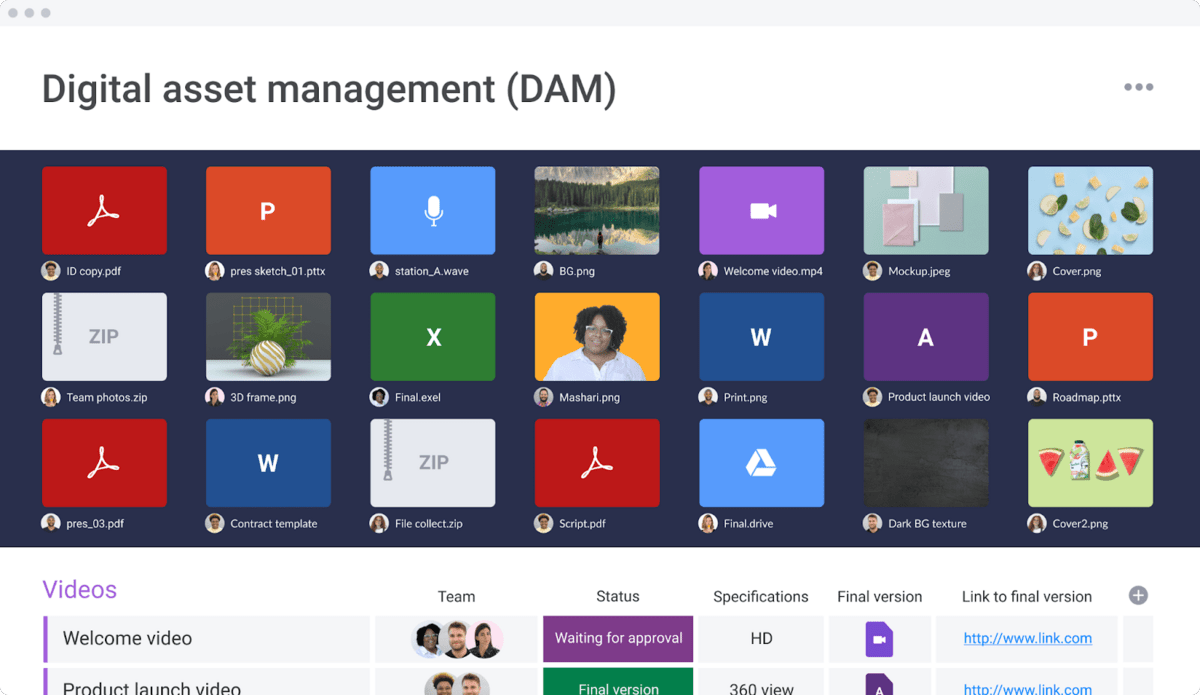
This template helps you centralize all your documents and information assets in a single place, track file revision history, and share files with specific team members.
You also get a filter feature that helps you search through your database with ease and find documents quickly. Our basic plan comes with 5 GB of storage, but you can grow all your way up to 1,000 GB.
2. Instant updates
Tracking the status of contributions and relevant documents is a crucial feature of any solid KMS.
Before you select a specific knowledge management solution, make sure it offers the ability to track updated statuses in real-time.
On a Work OS like monday.com, you can communicate with team members in context and stay in the loop with individual projects and tasks. You can add comments within items and chat with employees and clients instantly.
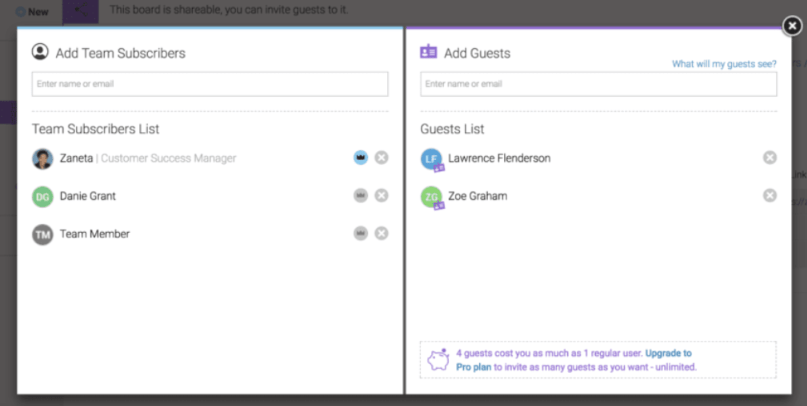
You can also use our automations to streamline status updates.
monday.com Work OS can automate more than 250,000 human actions, which can help you oversee your KMS while saving some time in the process.
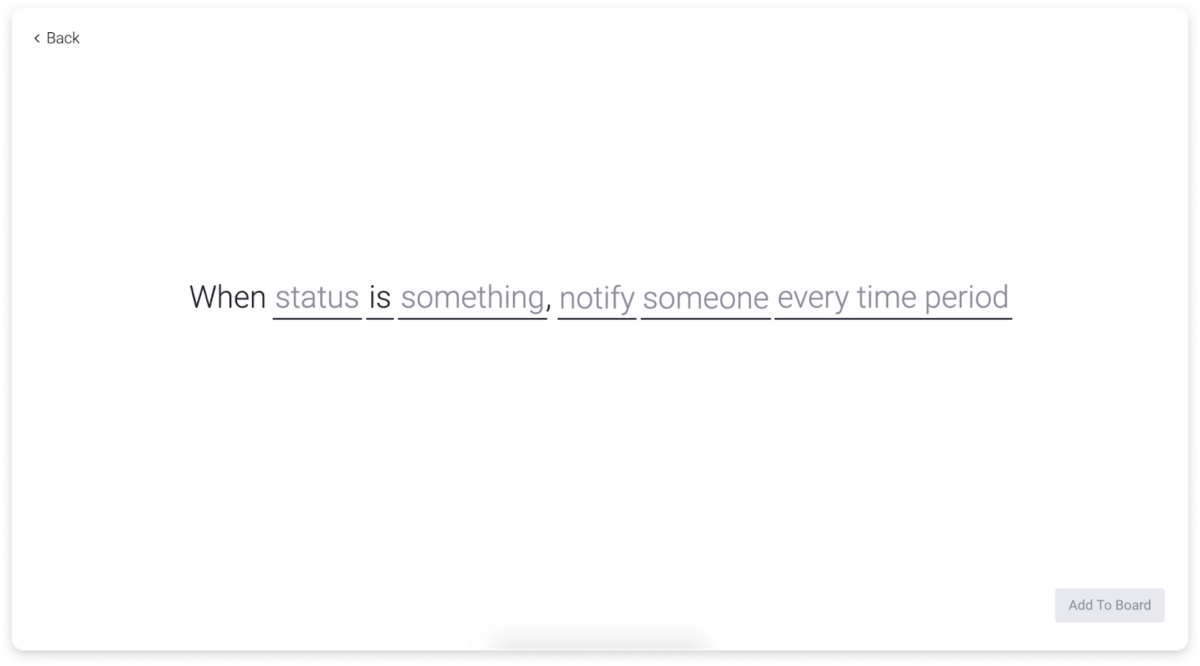
3. Collaboration
Without the right collaboration features in place, you won’t be able to fully implement a KMS. That’s why you should look for a platform that helps you centralize the way you work together into one place and remove silos between departments.
Bring in your entire team from the beginning and even invite clients and stakeholders as guests on monday.com Work OS.
This way, everyone involved in your KMS will be able to contribute and communicate with more ease.
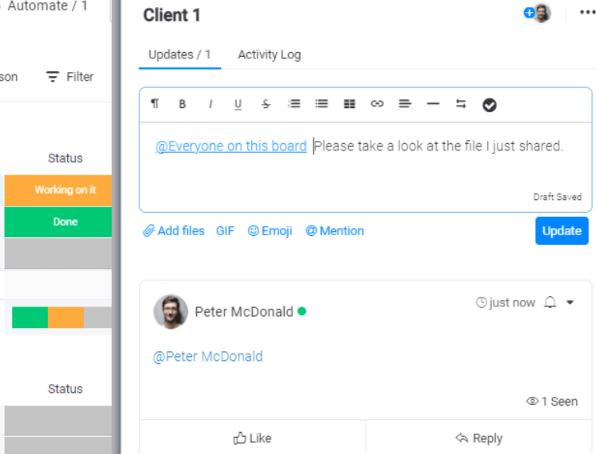
Some of the Work OS’ top collaboration features include:
- Tagging: tag specific team members and guests within tasks and activities
- Video conferencing: integrate video conferencing apps and schedule meetings with more ease
- Instant-messaging: communicate with your team in real-time
- Notifications: get relevant, timely notifications and make sure nothing slips through the cracks
- Task management: assign tasks to team members and measure progress
- Activity Log: explore the full history you’ve had with clients, teammates, and stakeholders
These features will help you communicate and solve potential issues much faster.
4. Accessibility and ease of use
Knowledge management solutions should be easily accessible for everyone involved. The system must provide timely, accurate information to users when they need it.
Otherwise, you might struggle with adoption. So, look for a system that makes it easy for everyone to access information and contribute. With monday.com, everyone on your team can access our cloud system on any device.
This is especially important for remote teams where people work from different locations. And because the monday.com Work OS focuses on intuitive visuals, you can move things around at will, which makes it easier to adopt the system with no training whatsoever.
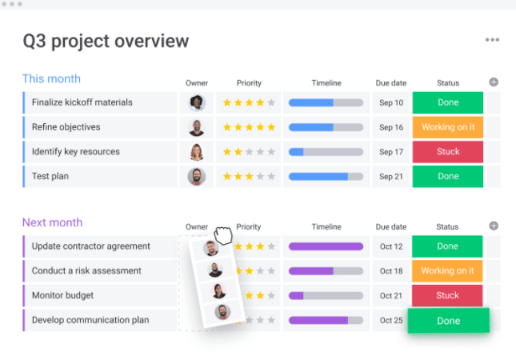
5. Integrations
The average organization uses around 80 apps, according to Statista. If your KMS doesn’t integrate with the software you already use, you’ll struggle to centralize information, which is core to an effective KMS.
Look for a system that offers seamless integration with tools you already use. On—yes, you guessed it—monday.com, you can integrate over 40 of your favorite apps and tools, including:
- Slack
- Zoom
- Facebook Ads
- Mailchimp
- Google Drive
And many more. You can explore our complete list of integrations here.
This will help you build a single source of truth for all your information and knowledge with more ease.
6. Reporting
To ensure your KMS is driving actual results for your business, you need a platform that helps you track the most relevant KPIs.
As Peter Drucker used to say: “If you can’t measure it, you can’t improve it.”
Make sure the system you select comes with powerful reporting dashboards that help you visualize the data that’s most relevant to you.
As we stated earlier, monday.com provides you with fully customizable dashboards to measure your team’s performance.
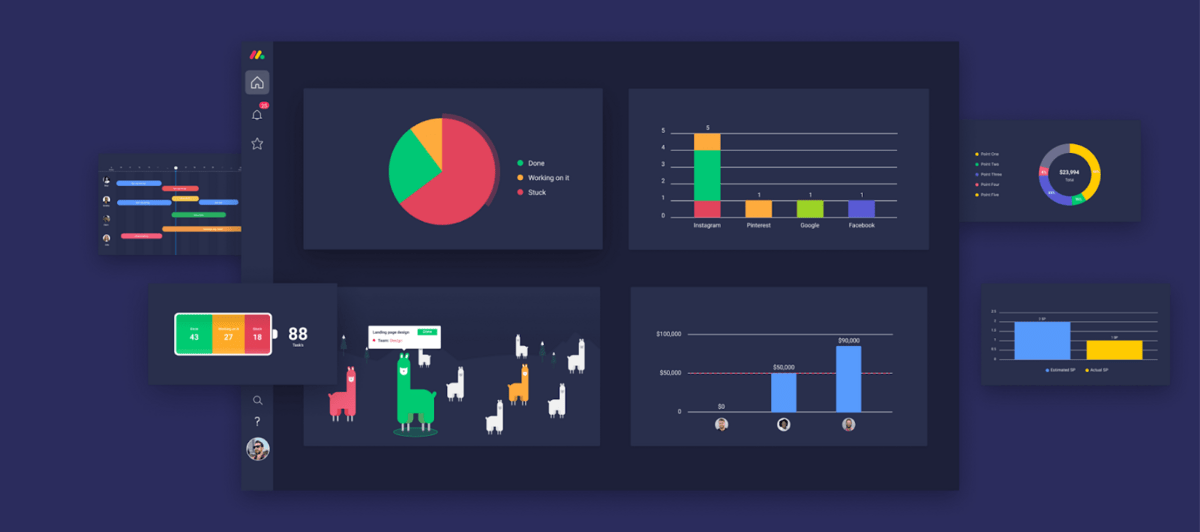
You can choose between 20+ widgets to “build” a dashboard that fits your exact needs. To get a more complete overview of our reporting functionality, watch this short video:
Ready to adopt a knowledge management system for your organization?
All organizations handle information and knowledge. As your business grows, you’ll need a system to coordinate, categorize, and manage organizational knowledge more efficiently.
Here’s where knowledge management software comes into play. Hopefully, now you have enough information to select the right system for your team.
monday.com helps you manage and automate knowledge management through a fully customizable platform that adapts to your exact needs. To start, we suggest you try out our digital asset management template. We take all the guesswork out of knowledge management systems.
Don’t miss more quality content!
Don’t miss more quality content!
